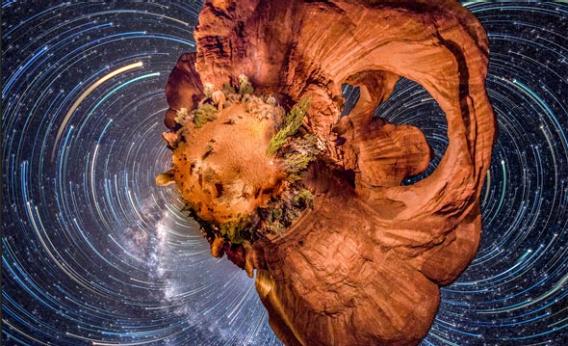Create a free profile to get unlimited access to exclusive videos, sweepstakes, and more!
Time-lapse: Planetary Panoramas

If I have but one complaint when I go outside to soak in the splendor of the heavens at night, it’s that I can only see one small part of the sky at once.
This is not the fault of geography, trees, or buildings blocking my view. It’s evolution. Or specifically, the result of endless random mutations guided by environmental pressures that have placed both our eyes in the front of our head, limiting our view.
This has distinct survival advantages (like binocular vision providing depth) but sadly means our own heads are in the way of more than half the sky.
But inside those heads are brains, and those brains live to solve such quirks of biology. For example, we invented technology that allowed us to build cameras with wide-angle lenses, and specifically allowed photographer Vincent Brady to mount four such cameras pointing in four different directions. His clever and artistic brain then used software to stitch together the resulting images to create a jaw-dropping and substantively beautiful time-lapse of the entire sky at once.
Behold: Planetary Panoramas.
That is so cool! And there are a couple of things worth explaining. Of course.
First are the weird star trails you see in many of the scenes. I’ve explained this before, but briefly: When you face north, east is to your right and west to your left, so the stars rise and set in a counterclockwise manner. If you face south, the reverse is true (west on your right, east on your left, and the stars move clockwise). If you look due east, the stars rise straight up, going over you head. Face west, and they move straight down to the horizon.
Normally, since you can only look in one direction at a time, you don’t have to deal with all these different movements all at once. But in the video we’re seeing the whole sky at the same time, with all those weird motions combined. So near the sky’s north pole the stars make little circles one way, and near the south pole (which is below the horizon in Michigan, where these shots were taken) they move the opposite way.
But there’s more! Once the images are stitched together, they can be mapped into different shapes. Just like you can take a map of the Earth and turn that into a spherical globe, a flattened Mercator projection, or any number of other types of shapes, you can do that with the sky as well. Brady reshaped the pictures several ways in the video, including using a (more or less) flat horizon facing east (at the 0:15 mark), which makes the stars rise out of the middle of the frame, and the same thing but facing south (at the 1:55 mark) and west (at the 2:19 mark) … all of which make the sky look very odd indeed.
But he also used something called the “Little Planet” effect, which is really weird. This takes the flat horizon and wraps it around into a circle, making the left side of the image touch the right, like rolling a rectangle up into a cylinder (or, more accurately a cone). The technique is pretty simple, and the end result is that it’s like you’re looking down on a tiny little planet or asteroid with the sky wrapped around it. This also tends to distort taller objects, lengthening them, so the arches (at the 0:30 mark) and hoodoos (at the 1:27 mark) look like they’re reaching toward you.
I’ll note that this is the opposite of the “all-sky” effect (at the 1:14 mark) where it looks like you’re looking up into the entire sky.
What fun! And all of this just from looking in all directions at once, and applying a little math to the result. I have to admit, I found it very disorienting (in a fun way) trying to pick out constellations and familiar landmarks in the sky during the video. Our puny human brains aren’t used to processing information this way and can get pretty twisted up when presented with information that’s out of the ordinary.
I think that’s all for the better. Our brains are pelted with information all the time, and sometimes it doesn’t necessarily jibe with how we think we see the Universe. But we may not be seeing it correctly! I think a good old jolt to the gray matter is an excellent way to make sure we don’t get complacent, and to ensure we don’t get too stuck in our views.


























